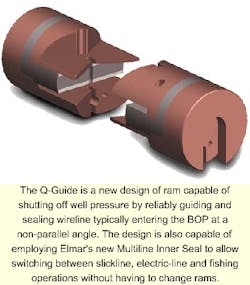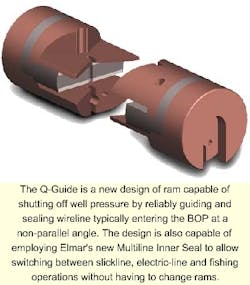DRILLING & PRODUCTION
New wireline ram design
Elmar Services Ltd has introduced a new design of wireline BOP ram, Q-Guide, for the global market. This new design of ram is capable of shutting off well pressures by reliably guiding and sealing wireline that enter the BOP at a non-parallel angle. The design is also capable of employing Multiline Inner Seal to allow switching among slickline, electric-line and fishing operations without having to change rams. Since this is suited to use in any wireline BOP, the Q-Guide and Multiline Inner Seal offer significant cost and reliability benefits over more traditional products.
Shutting off well pressure is essential should wireline damage or problems in maintaining a seal at the grease head occur. During the closing stroke, the rams must guide the wireline into a semi-circular groove in the ram body and create a fluid-tight seal without damaging the cable. However, recent reports have pointed to difficulties encountered in traditional ram designs when wireline enters at certain angles to the axis of the BOP bore, which can often occur in deviated wells. If the rams close before the wireline is positioned in the line groove, the cable can be trapped and damaged, thus reducing the safety and integrity of the operation. This problem has occurred in the field and has been confirmed in trials. It is found to be more likely to happen with large bore BOPs of 4" ID and larger.
As a result, development of this ram provides a positive alignment for the wireline on closure. Special guides on either side of the inner seal restrict the wireline so that the section of line contacting the seal is always centered and parallel to the BOP axis. These rams will be supplied as standard for all future wireline BOP operations.
Also, the new Multiline Inner Seals can be used in conjunction with this ram to create a universal 'multiline' ram. Although the line groove in the inner seal is sized for 5/16" line, the seal is able to seal around any line from 0.092" OD (Outside Diameter) to 0.312" (5/16") OD. To date, this combination of the rams and the seals has demonstrated excellent reliability in field trials conducted with success in the North Sea, Gulf of Mexico, and Asia Pacific for a number of major service companies at the end of 2000.
John Swansey, Sales and Marketing Director, said that these new capabilities provide significantly improved performance and cost benefits over previous generations of wireline BOP rams. Rethinking the design of standard wireline BOP rams has led to developing a system that is applicable in every wireline situation. The combination of rams and seals offers significant commercial benefits to companies operating in environments where reliability, quality and performance are critical.
Reliable HP/HT digital interpretation caliper logging technology
Continuing to pioneer the development of accurate downhole calipers, which can mechanically record downhole data, Expro International Group PLC can convert to e-data at surface using the latest digital scanning technology. This new development, DigiCal, combines the reliable HP/HT capabilities of Kinley's calipers with the latest in digital interpretation technology. This offers unique solutions in corrosion monitoring suited for all locations, especially extreme conditions and remote sites.
This tool can be run to a maximum temperature of 600°F and a maximum pressure of 20,000 psi with no limit of H2S or CO2 concentrations. Furthermore, the caliper does not suffer from any pressure or temperature related drift on sensors over recorded depths of up to 30,000 ft. The mechanical nature enables it to continuously record the position of each feeler simultaneously, rather than taking sequential spot readings of the position of each feeler in turn, as is the case with its electronic counterparts. The combination of both the tool's temperature stability and continuous independent recording of each feeler results in an unparalleled accuracy and resolution.
The system enables mechanically recorded data in the tool to be converted into a more convenient electronic format as soon as the tool comes to surface. The resulting e-data can then be processed using unique interpretation and visualization software to produce a corrosion log at the wellsite. The e-data can also be transmitted to the Corrosion Analysis Center for a full analysis by a team of specialists within hours.
The largest fleet of multi-finger calipers in the world has been achieved through the acquisition of the Kinley Corporation in March 2000. Kinley's range of calipers allow tubing and casing sizes from 1.9" (49mm) up to 13 5/8" (344mm) to be logged. Bob Will, Business Stream Director for Cased Hole Services, commented: "The Kinley Caliper has long been accepted as the industry standard when it comes to monitoring well bore corrosion and deformation. Integrating these capabilities with the latest digital technology for analyzing logging data gives the ultimate visualization system needed in remote locations."
Rotating control head plays key role
A rotating control head system technology, RiserCaptrademark External Riser Rotating Control Head System Prototype, has been successfully proven in a field trial to drill in deepwater with lightweight fluids by Weatherford International, Inc. The field trial, which was conducted in a 10,000 ft. well in approximately 1,000 ft of water, took place on the Petrobras XVII semisubmersible in the Albacora Field of the Campos Basin, Offshore Brazil, as part of the Petrobras Joint Industry Project (JIP). The JIP's objective is to adopt lightweight drilling fluid equipment and techniques for use in deepwater floating drilling and involves several other operating and service companies.
The RiserCap is a rotating control head system specifically designed for deepwater floating drilling rig applications. It replaces the conventional slip-joint system with a specialized Rotating Control Head (RCH) based system in order to control the pressure created in the marine drilling riser if a lightweight drilling fluid system is used on a deepwater drilling rig.
During the field trials, this system was connected to the drilling choke and surface separation system with flexible redundant hoses after being installed on top of a closed riser slip joint. The RiserCap bowl, bearing assembly and stripper rubbers sealed the annulus of the well at the top of the riser and held the required pressure while drilling ahead. The flexible flow lines handled the diverted annulus returns to the choke manifold while accommodating heave movements of the floating rig.

